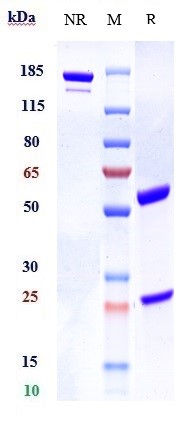Anti-GFRAL Reference Antibody (NGM120)
Recombinant Antibody
- 产品详情
- 实验流程
Application
| FC, Kinetics, Animal Model |
|---|---|
| Primary Accession | Q6UXV0 |
| Reactivity | Human |
| Clonality | Monoclonal |
| Isotype | IgG1 |
| Calculated MW | 44518 Da |
| Target/Specificity | GFRAL |
|---|---|
| Endotoxin | < 0.001EU/ µg,determined by LAL method. |
| Conjugation | Unconjugated |
| Expression system | CHO Cell |
| Format | Purified monoclonal antibody supplied in PBS, pH6.0, without preservative.This antibody is purified through a protein A column. |
| Name | GFRAL {ECO:0000303|PubMed:28846097, ECO:0000312|HGNC:HGNC:32789} |
|---|---|
| Function | Brainstem-restricted receptor for GDF15 hormone, which triggers an aversive response, characterized by nausea, vomiting, and/or loss of appetite in response to various stresses (PubMed:28846097, PubMed:28846098, PubMed:28846099, PubMed:28953886, PubMed:36630958). The aversive response is both required to reduce continuing exposure to those stresses at the time of exposure and to promote avoidance behavior in the future (PubMed:28846097, PubMed:28846098, PubMed:28846099, PubMed:28953886, PubMed:36630958). The GDF15-GFRAL aversive response is triggered by stresses, such as anticancer drugs (camptothecin or cisplatin), cancers or drugs such as metformin (PubMed:32661391). Upon interaction with its ligand, GDF15, mediates the GDF15-induced autophosphorylation and activation of the RET tyrosine kinase receptor, leading to activation of MAPK- and AKT- signaling pathways (PubMed:31535977, PubMed:32661391). Ligand- binding activates GFRAL-expressing neurons localized in the area postrema and nucleus tractus solitarius of the brainstem (By similarity). The GDF15-GFRAL signal induces expression of genes involved in metabolism, such as lipid metabolism in adipose tissues (PubMed:32661391). |
| Cellular Location | Cell membrane; Single-pass membrane protein; Extracellular side |
| Tissue Location | Expressed in the brainstem, restricted to cells in the area postrema and the immediately adjacent region of the nucleus tractus solitarius (at protein level) (PubMed:28846097, PubMed:28846098). Detected at low levels in testis and adipose tissue (PubMed:28846097). |
Research Areas
For Research Use Only. Not For Use In Diagnostic Procedures.
Application Protocols
Provided below are standard protocols that you may find useful for product applications.
终于等到您。ABCEPTA(百远生物)抗体产品。
点击下方“我要评价 ”按钮提交您的反馈信息,您的反馈和评价是我们最宝贵的财富之一,
我们将在1-3个工作日内处理您的反馈信息。
如有疑问,联系:0512-88856768 tech-china@abcepta.com.
¥ 1,500.00
Cat# APR10419























 癌症的基本特征包括细胞增殖、血管生成、迁移、凋亡逃避机制和细胞永生等。找到癌症发生过程中这些通路的关键标记物和对应的抗体用于检测至关重要。
癌症的基本特征包括细胞增殖、血管生成、迁移、凋亡逃避机制和细胞永生等。找到癌症发生过程中这些通路的关键标记物和对应的抗体用于检测至关重要。 为您推荐一个泛素化位点预测神器——泛素化分析工具,可以为您的蛋白的泛素化位点作出预测和评分。
为您推荐一个泛素化位点预测神器——泛素化分析工具,可以为您的蛋白的泛素化位点作出预测和评分。 细胞自噬受体图形绘图工具为你的蛋白的细胞受体结合位点作出预测和评分,识别结合到自噬通路中的蛋白是非常重要的,便于让我们理解自噬在正常生理、病理过程中的作用,如发育、细胞分化、神经退化性疾病、压力条件下、感染和癌症。
细胞自噬受体图形绘图工具为你的蛋白的细胞受体结合位点作出预测和评分,识别结合到自噬通路中的蛋白是非常重要的,便于让我们理解自噬在正常生理、病理过程中的作用,如发育、细胞分化、神经退化性疾病、压力条件下、感染和癌症。







